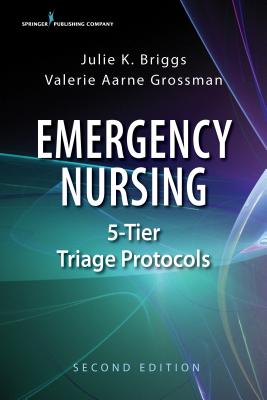“The authors not only encourage data gathering, they emphasize the qualities of personal interactions, courtesy and sensitivity, and consideration to upgrade triage category when history is hampered by youth, age, impairment of faculties, or language ability that might otherwise conceal potential problems. Appropriate treatments to initiate at triage are indicated where needed. This book puts forward a practical way of coming back to basics and helps categorize priority for patients. As an educator or manager, I would feel confident that, with it, my nurses are being prepared to make safe decisions with an accurate program that reflects current thinking in triage strategy.”
-Tom Trimble, RN, CEN, BA, ASN, AA
Editor and Publisher
Emergency Nursing World
This critical-thinking blueprint for the triage nurse delivers essential knowledge for accurate decision-making in emergency triage situations. Formatted to provide easily accessible and retrievable information, the manual facilitates rapid recognition and understanding of acuity levels and their application to patient care. The newly updated second edition reflects current health conditions and scenarios in EDs, urgent care centers, offices, and first aid centers, both domestic and international. It contains important new information on program development, training, and quality management along with useful tips and tools. Completely new protocols, additional case studies, and quality management guidelines and tools further add to the merit of the second edition.
The resource addresses a wide range of both adult and pediatric conditions that are system-based and listed in alphabetical order. Each protocol has been developed to ensure accuracy and consistency, regardless of which 5-tier triage system is in use. Abundant case studies and multiple appendices provide additional information to support the protocols, broadening the nurse’s scope of knowledge and prompting in-depth examination of potentially lethal conditions. Additionally, appendices contain valuable training materials for program development, training, and quality management tips and tools.
New to the Second Edition:
- Updated protocols reflecting current health conditions/situations in EDs, urgent care centers, offices, and first aid centers
- Important new information on program development, training, and quality management tips and tools
- Additional material including mass casualty, exposure (biological, chemical, disease), military care, infections (isolation concerns), behavioral issues (violence), and narcotic overdose
- New case studies
- Developing a triage program
- Quality management guidelines and tools
Key Features:
- Facilitates consistency in triage decisions among different nurses
- Uses health care resources appropriately and efficiently
- Sets minimum expectations for triage decisions
- Guides nurses in asking the right questions, determining how soon the patient must be seen, and interventions to consider
- Serves as a valuable reference for both new and experienced nurses
- Serves as a training tool in orientation
 Jacket, Women
Jacket, Women
 Woolend Jacket
Woolend Jacket
 Western denim
Western denim
 Mini Dresss
Mini Dresss
 Jacket, Women
Jacket, Women
 Woolend Jacket
Woolend Jacket
 Western denim
Western denim
 Mini Dresss
Mini Dresss
 Jacket, Women
Jacket, Women
 Woolend Jacket
Woolend Jacket
 Western denim
Western denim
 Mini Dresss
Mini Dresss
 Jacket, Women
Jacket, Women
 Woolend Jacket
Woolend Jacket
 Western denim
Western denim
 Mini Dresss
Mini Dresss
 Jacket, Women
Jacket, Women
 Woolend Jacket
Woolend Jacket
 Western denim
Western denim
 Mini Dresss
Mini Dresss






























































